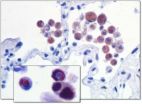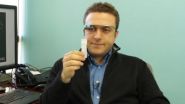(Press-News.org) Materials scientists have long known that introducing defects into three-dimensional materials can improve their mechanical and electronic properties. Now a new Northwestern study finds how defects affect two-dimensional crystalline structures, and the results hold information for designing new materials.
In packed, two-dimensional crystalline systems, such as in photonic two-dimensional crystals, the particles are organized in hexagonal lattices. One particle is in the center of the hexagon with six neighboring particles around it. A defective lattice is when the center particle has one extra or one fewer neighbor, creating a heptagon or pentagon. Two defects of similar types—two pentagons or two heptagons—will repel each other. Two defects of opposite types—one pentagon and one heptagon—will attract one another and proliferate.
"If there is one heptagon or one pentagon, then the structure is strongly distorted," says the paper's coauthor Monica Olvera de la Cruz, Lawyer Taylor Professor of Materials Science and Engineering. "But if you have one pentagon and one heptagon, then the distortion is relieved. The pairs cancel each other out."
Impure particles can cause defects in all types of systems. One impurity is a difference in particle size, which is naturally seen in granular materials, nanoparticles, and colloidal crystals. To see how a size disparity would affect the crystalline order and the system's physical properties, Olvera de la Cruz and postdoctoral fellow Zhenwei Yao devised a model system of soft particles, such as functionalized nanoparticles with grafted chains including nucleic acids or thiols. They made one of the particles in the lattice much larger than the surrounding particles.
"When we expanded one particle, all the neighboring particles were squeezed and stressed," says Yao, coauthor of the paper. "The bigger we made the particle, the more defects it caused."
The larger particle impurity induced defects. Surprisingly, however, instead of repelling one another and distorting the crystalline order, the defects settled into harmony.
"People would expect for them to repel," Olvera de la Cruz says. "But they all came together and arranged to generate a lower energy configuration. The defects around the impurity particles mediate the attractions between impurity particles."
The defects restored order, creating a "screen," or buffer, to protect the rest of the structure from the stress of the added impurity.
This finding could lead to new ways of engineering materials, supporting the Materials Genome Initiative. Creating materials with new properties by adding impurities can be tricky. If the impurities cause defects that induce attractions between impurity particles, then they might create regions where impurities aggregate. "That generates an interface of two materials that can be very damaging," Olvera de la Cruz says. "The impurities have to be very well controlled."
By changing the size of particles, materials researchers may be able to engineer defects in a convenient and precise manner.
INFORMATION:
The research is described in the paper, "Polydisperity-driven topological defects as order-restoring excitations," published online March 24 in the Proceedings of the National Academy of Sciences.
Expanding particles to engineer defects
Northwestern researchers find that adding an impurity can create order
2014-04-08
ELSE PRESS RELEASES FROM THIS DATE:
More insights from tissue samples
2014-04-08
This news release is available in German.
They discovered that the so-called HOPE method allows tissue samples to be treated such that they do not only meet the requirements of clinical histology, but can still be characterised later on by modern methods of proteomics, a technique analysing all proteins at once. This is successful, since the structure of the tissue is "fixed" in a way that the protein molecules remain accessible for systematic analysis. This technique therefore meets current requirements in terms of a more personalised medicine and thus opens up ...
Few Americans know where elected officials and candidates stand on government support for research
2014-04-08
ALEXANDRIA, Va.—April 8, 2014—Two-thirds of Americans (66%) say it's important for candidates running for office to assign a high priority to funding medical research, according to America Speaks, Volume 14, a compilation of key questions from public opinion polls commissioned by Research!America. Polling shows that Americans place a high value on U.S. leadership in medical innovation, yet only 12% say they are very well informed about the positions of their senators and representative when it comes to their support of medical and scientific research. http://www.researchamerica.org/poll_summary. ...
Thinking about a majority-minority shift leads to more conservative views
2014-04-08
Facing the prospect of racial minority groups becoming the overall majority in the United States leads White Americans to lean more toward the conservative end of the political spectrum, according to research published in Psychological Science, a journal of the Association for Psychological Science.
The findings suggest that increased diversity in the United States could actually lead to a wider partisan divide, with more White Americans expressing support for conservative policies.
Psychological scientists Maureen Craig and Jennifer Richeson of Northwestern University ...
Logo color affects consumer emotion toward brands, MU study finds
2014-04-08
COLUMBIA, Mo. – Many studies have shown that a company's logo is one of the most important aspects of marketing and advertising a brand, or features that distinctly identifies a company's product or service from its competitors. Now, a researcher at the University of Missouri has found that the specific colors used in a company's logo have a significant impact on how that logo, and the brand as a whole, is viewed by consumers.
Jessica Ridgway, a doctoral student in the MU Department of Textile and Apparel Management, surveyed 184 adults using generic logos of different ...
Synthetic gene circuits pump up cell signals
2014-04-08
Synthetic genetic circuitry created by researchers at Rice University is helping them see, for the first time, how to regulate cell mechanisms that degrade the misfolded proteins implicated in Parkinson's, Huntington's and other diseases.
The Rice lab of chemical and biomolecular engineer Laura Segatori has designed a sophisticated circuit that signals increases in the degradation of proteins by the cell's ubiquitin proteasome system (UPS).
The research appears online today in Nature Communications.
The UPS is essential to a variety of fundamental cellular processes, ...
Unexpected results in cancer drug trial
2014-04-08
Research from the University of Southampton has shown a drug, used in combination with chemotherapy to treat advanced colorectal cancer, is not effective in some settings, and indeed may result in more rapid cancer progression.
The New EPOC study, published in The Lancet Oncology and funded by Cancer Research UK, evaluated whether the drug cetuximab and chemotherapy together worked better than chemotherapy alone as a treatment in addition to surgery for people with bowel cancer that had spread to the liver but could be surgically removed. In the trial patients either ...
Scalable CVD process for making 2-D molybdenum diselenide
2014-04-08
Nanoengineering researchers at Rice University and Nanyang Technological University in Singapore have unveiled a potentially scalable method for making one-atom-thick layers of molybdenum diselenide -- a highly sought semiconductor that is similar to graphene but has better properties for making certain electronic devices like switchable transistors and light-emitting diodes.
The method for making two-dimensional molybdenum diselenide uses a technique known as chemical vapor deposition (CVD) and is described online in a new paper in the American Chemical Society journal ...
Study: Black carbon is ancient by the time it reaches seafloor
2014-04-08
A fraction of the carbon that finds its way into Earth's oceans -- the black soot and charcoal residue of fires -- stays there for thousands for years, and a new first-of-its-kind analysis shows how some black carbon breaks away and hitches a ride to the ocean floor on passing particles.
The study by scientists from Rice University, the University of California, Irvine, and the University of South Carolina offers the first detailed analysis of how black carbon gets into deep ocean sediments, as well as an accounting of the types and amounts of black carbon found in those ...
Graphene nanoribbons as electronic switches
2014-04-08
One of graphene's most sought-after properties is its high conductivity. Argentinian and Brazilian physicists have now successfully calculated the conditions of the transport, or conductance mechanisms, in graphene nanoribbons. The results, recently published in a paper in EPJ B, yield a clearer theoretical understanding of conductivity in graphene samples of finite size, which have applications in externally controlled electronic devices.
When the conductivity is high, the electrons, carriers of electrical current, are minimally hampered during transport through graphene. ...
Scientists use Google Glass to map the future of medical testing (video)
2014-04-08
WASHINGTON, April 8, 2014 — A team of researchers at UCLA has transformed Google Glass into powerful, wearable medical testing laboratory. Aydogan Ozcan and his team developed an application that reads dozens of different types of diagnostic tests for malaria, prostate cancer and HIV, to name a few. Glass uploads the results to secure servers and provides anonymous data to epidemiologists. In the American Chemical Society's (ACS') newest Breakthrough Science video, Ozcan demonstrates how the app works, and explains the broad impact it could have on medicine. The video is ...
LAST 30 PRESS RELEASES:
How talking slows eye movements behind the wheel
The Ceramic Society of Japan’s Oxoate Ceramics Research Association launches new international book project
Heart-brain connection: international study reveals the role of the vagus nerve in keeping the heart young
Researchers identify Rb1 as a predictive biomarker for a new therapeutic strategy in some breast cancers
Survey reveals ethical gaps slowing AI adoption in pediatric surgery
Stimulant ADHD medications work differently than thought
AI overestimates how smart people are, according to HSE economists
HSE researchers create genome-wide map of quadruplexes
Scientists boost cell "powerhouses" to burn more calories
Automatic label checking: The missing step in making reliable medical AI
Low daily alcohol intake linked to 50% heightened mouth cancer risk in India
American Meteorological Society announces Rick Spinrad as 2026 President-Elect
Biomass-based carbon capture spotlighted in newly released global climate webinar recording
Illuminating invisible nano pollutants: advanced bioimaging tracks the full journey of emerging nanoscale contaminants in living systems
How does age affect recovery from spinal cord injury?
Novel AI tool offers prognosis for patients with head and neck cancer
Fathers’ microplastic exposure tied to their children’s metabolic problems
Research validates laboratory model for studying high-grade serous ovarian cancer
SIR 2026 delivers transformative breakthroughs in minimally invasive medicine to improve patient care
Stem Cell Reports most downloaded papers of 2025 highlight the breadth and impact of stem cell research
Oxford-led study estimates NHS spends around 3% of its primary and secondary care budget on the health impacts of heat and cold in England
A researcher’s long quest leads to a smart composite breakthrough
Urban wild bees act as “microbial sensors” of city health.
New study finds where you live affects recovery after a hip fracture
Forecasting the impact of fully automated vehicle adoption on US road traffic injuries
Alcohol-related hospitalizations from 2016 to 2022
Semaglutide and hospitalizations in patients with obesity and established cardiovascular disease
Researchers ‘listen in’ to embryo-mother interactions during implantation using a culture system replicating the womb lining
How changing your diet could help save the world
How to make AI truly scalable and reliable for real-time traffic assignment?
[Press-News.org] Expanding particles to engineer defectsNorthwestern researchers find that adding an impurity can create order

